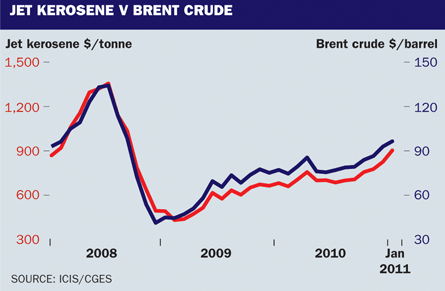The International Energy Agency raised an alarming note as our power-hungry lives got back into gear after the holidays. "Oil prices are entering a dangerous zone for the global economy. The oil import bills are becoming a threat to the economic recovery. This is a wake-up call to the oil-consuming countries and to the oil producers," it said.
What is worth waking up for, says IEA chief economist Fatih Birol, is several weeks' steady price rises, with benchmark Brent Crude opening January trading with a push to $95/barrel, its highest price in more than two years.
According to the IEA, oil import costs for the 28 Organisation for Economic Cooperation and Development countries had shot up by one-third to $790 by the end of 2010. Within Europe, the extra $70 billion cost equals the combined budget deficits of Greece and Portugal.
 |
|---|
Whether rising fuel bills derail economic recovery generally, from an airline industry perspective oil prices - closely tracked by jet kerosene prices - are in a trouble zone. In 2010 Brent Crude averaged around $80/barrel and industry talk in 2010 focused on passenger demand rather than fuel, which had dominated all concerns as its price rose to historic highs in summer 2008.
However, the International Air Transport Association points out that jet fuel prices at the close of 2010 were more than one-fifth higher than a year earlier. And, if those prices prevail for 2011, the industry's fuel bill will have risen by $22 billion. To put that in perspective, the industry set an all-time profit record in 2010, of $15.1 billion. Last year, airlines spent an IATA-estimated $139 billion on fuel, accounting for 26% of operating expenses, assuming Brent Crude at $79.
Oil at $100/barrel is entirely likely. Even before the recent surge into the $90 range, Bank of America Merrill Lynch commodity strategist Sabine Schels forecast that Brent would break through $100 in 2011, but average $88. Prices have been rising steadily since December 2008, when they had plunged into a $40s trough following the peak in the $130 range in July 2008, which took jet fuel prices to $1,360/tonne.
WINTER GLOOM
That long climb has been given a push by a hard winter in Europe and North America. As Leo Drollas, chief economist at the Centre for Global Energy Studies in London points out, jet fuel is a middle-distillate crude oil derivative similar to heating oil. Refineries have to choose between the two. Airlines, he says, are paying for a cold winter, with jet fuel set to average $906/tonne for this month. For the year, Drollas is less optimistic than Schels, expecting Brent to average $93, which translates into about $900/tonne for jet fuel.
In the short term, there is not much airlines can do to counter rising fuel bills. Hedging - essentially a two-way bet against fuel price movements - can keep the per-tonne fuel bill more or less constant. It is a technique used effectively by "strategic hedgers" such as Air France, British Airways or Lufthansa, which always maintain hedged positions.
But, says Drollas, "tactical hedgers" such as Ryanair, which try to dip into the hedging market when they fear rising fuel prices, often lose; airlines that had panicked and hedged against sky-high prices in 2008 found themselves paying way over market prices after oil collapsed in August 2008. Forecasting oil prices, he notes, is a mug's game.
Otherwise, airlines can hope to raise prices to cover rising costs. However, industry analyst Chris Tarry of CTAIRA says price rises only "stick" if there is excess demand for travel. Asian markets are strong, he says, but in Europe, where the big volume market is for leisure travel, the demand outlook is not good so raising prices would be a volume killer.
That condition puts airlines in a bind. They cannot go on absorbing rising fuel costs, says Terry, but their greatest threat is lack of passenger demand.
The IEA's worry about rising oil prices threatening economic recovery bodes ill for airlines either way. Schels believes that prices above $100/barrel are not sustainable as they cross the "pain threshold" for OECD countries. Drollas notes that the Saudis want to keep oil trading in the $70-90/barrel range and are raising output in a bid to take the edge off recent rises.
Oil in the $80-90 range, then, looks like a good bet; not high enough to derail recovery, but high enough to keep global growth in check - and to keep airlines sweating the fuel bills.
Source: Flight International























